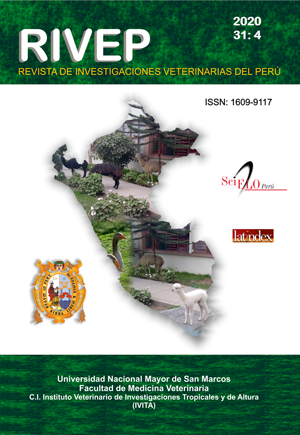Fitting non-linear mixed models for the description of bovine lactation curves under grazing in El Mantaro, Junín, Peru
DOI:
https://doi.org/10.15381/rivep.v31i4.19027Keywords:
lactation curves, nonlinear mixed models, Wood function, Wilmink function, Junín, PerúAbstract
Conventionally, lactation curves of confined dairy cattle have been modelled using non-linear, fixed effects models (MNL). The aims of this study were (i) to assess the fit of non-linear mixed models (MMNL), using the Wood (y = β1xβ2e-β3x) and Wilmink (y = β1 + β2e-0.009x+ β3x) functions to analyse lactation curves under grazing and in the context of heteroscedasticity and correlated errors, and (ii) to evaluate the effect of parity and calving season on the curve parameters for both functions. The Wood and the Wilmink functions were fitted, using MNL and MMNL to 600 milk production records corresponding to 42 lactations from 2004 to 2012 from dairy cattle with 1, 2 or >3 calvings in the wet or dry season from the herd in the IVITA-El Mantaro Research Station (Junin, Perú). For both functions, the MMNL outperformed the MNL in terms of residual standard error reduction, increasing of the likelihood, and being able to model random effects and correlations for all the parameters of both functions. The MMNL was also able to model heteroscedasticity by means of a variance function and correlated errors by means of a spatial correlation function. There were not important differences in the fitting of the Wood or Wilmink functions in terms of the residual standard error or the Akaike or bayesian information criteria. Both, parity and calving season did not have significant effects on the curve parameters of the Wood and Wilmink functions. It is concluded that the MMNL is an excellent tool to model lactation curves both at the population- or individual-level.
Downloads
Downloads
Published
Issue
Section
License
Copyright (c) 2020 Miguel Ara Gómez, Ysela Agüero Palacios

This work is licensed under a Creative Commons Attribution-NonCommercial-ShareAlike 4.0 International License.
AUTHORS RETAIN THEIR RIGHTS:
a. Authors retain their trade mark rights and patent, and also on any process or procedure described in the article.
b. Authors retain their right to share, copy, distribute, perform and publicly communicate their article (eg, to place their article in an institutional repository or publish it in a book), with an acknowledgment of its initial publication in the Revista de Investigaciones Veterinarias del Perú (RIVEP).
c. Authors retain theirs right to make a subsequent publication of their work, to use the article or any part thereof (eg a compilation of his papers, lecture notes, thesis, or a book), always indicating the source of publication (the originator of the work, journal, volume, number and date).



